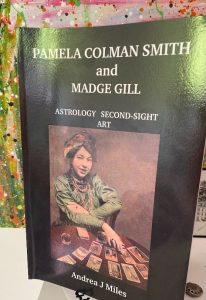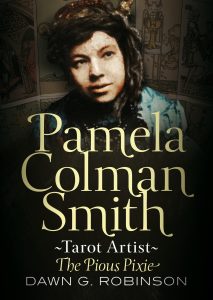I recently received a copy of this delightful new book on Pamela Colman Smith (and Madge Gill) by Andrea Miles.
The author’s unique conceptual approach is a concise biography of Smith and Gill, coupled with an interpretation of each woman’s birth chart, effectively illustrating astrology in action.
When writing Pamela Colman-Smith: The Pious Pixie, I viewed Pamela’s birth chart and and read an interpretation. I believed that applying an astrological reading to Pamela’s life would be of great interest; however, I am not an astrologer, so I stuck to my own research and plan, which was to investigate Pamela’s largely unknown later life in Cornwall.
Andrea, however, is qualified for she was taught astrology by a professional, making her perfectly suited to the task. She has created astrological interpretations based on rectified natal charts (where time of birth is unknown but estimated) adding a great deal of insight to the life events and decisions which impacted the lives of the two women.
Any book on tarot artist, Pamela, which helps to fill some of the gaps in her story is, to me, fascinating, so I very much enjoyed this highly readable, astrological approach. I also learned new (to me) information, as my focus was on very much on her ‘Cornwall’ years.

For example, I did not know that Pamela was imprisoned for one evening in Holloway in connection with her suffrage activities, information originally uncovered by academic, Elizabeth Foley O’Connor. This very real commitment to suffrage and equality was sadly underplayed in my own book.
Additionally, I did not realise that her visitor, Arthur Ransome, was cousin to Christabel Marshall (Edy Craig’s partner) so the author’s genealogical research certainly paid off, demonstrating how interlinked the characters in Pamela’s story are.
To discover that Pamela appeared in performance before the King at Sandringham in 1904, emphasises what an admired performer she truly was, too. This all makes her move to Cornwall the more incredible; it was a huge life shift, which my book attributes to the strong interest she developed in Catholicism.

Of course, there is also information about Nora Lake, Pamela’s friend of many years (she did not have many, though a huge number of acquaintances) who is still very much shrouded in mystery.
Madge Gill, I admit, I did not know anything about, though I rather enjoyed her pen and ink art illustrated in the book (rather more than Pamela’s esoteric artistic offerings, truth be told).
She was another ‘outsider’ artist and visionary. It was interesting ‘getting to know’ Madge whose life was an immense struggle. Her story takes us through a childhood at Barnardo’s, from where she was shipped as a steerage passenger, in 1896, to Canada at the age of 12. In Canada, she became a domestic servant. As Miles says, “she had a disjointed childhood and her life story was one of triumph over much adversity and pain”. She married her first cousin and her first son was born out of wedlock. Her artwork began after the deaths of two of her children.
The book also introduces us to another woman of note, Dr Helen Boyle, who was Madge Gill’s doctor. She ran a progressive hospital called The Lady Chichester Hospital, in Hove, which treated ‘nervous’ women and children, with a focus on ‘women treating women’, the first hospital of its kind and holistically therapeutic in nature.
It would be unfair to give too much away, so to find out more about these incredible women, who had their own struggles, (especially in the case of Gill) do give this highly readable book a try.
Pamela Colman Smith and Madge Gill: Astrology Second-sight Art, by Andrea J. Miles, is published by independent publishers, Green Magic, and is available online.

